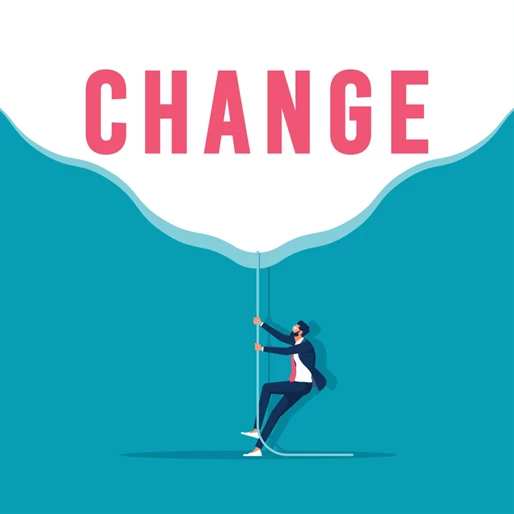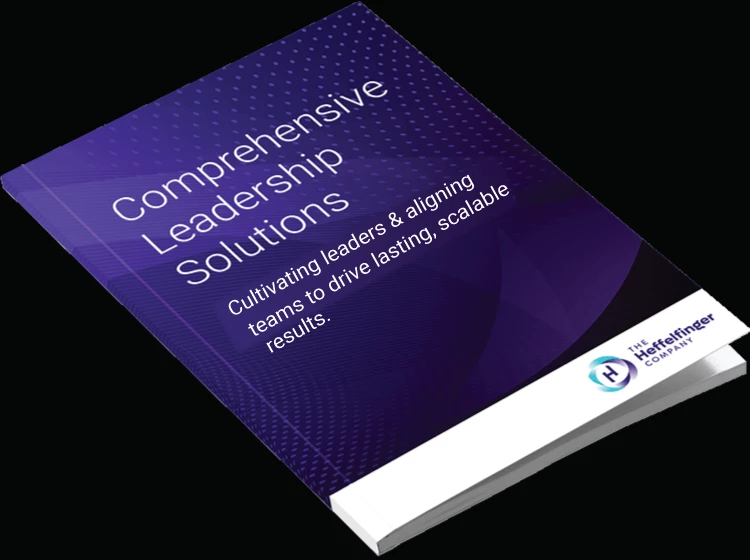"The improvisational ability to lead adaptively relies on responding to the present situation rather than importing the past into the present and laying it on the current situation like an imperfect template.”
~ Ronald A. Heifetz
Our first blog discussed reimaging our organizations to be more adaptive and agile and a better "fit" for an increasingly volatile and complex world, which means also reimagining our leadership.
As the events of 2020 demonstrated, traditional ways of thinking about business change and leadership are not up to the task. Organizational change can no longer be an event to manage on a path to a new status quo or “new normal.”
The fact is, we live in a state of dynamic non-equilibrium. This means that organisms, ecosystems, and organizations alike are operating in a constant state of flux. Conditions (both internal and external) are never quite the same from day today. The changes we face aren't moving us towards some 'new state' of stability, order, or predictability. We are and will continue to be in a constant state of dynamic non-equilibrium.
To thrive in this environment, organizations need to become adaptive. Adaptive Organizations require Adaptive Leadership. There is so much to say about Adaptive Leadership – we could write a whole series of blogs on just this topic.
Adaptive Leadership is the ONLY form of leadership that will be successful going forward. The speed of change requires us to adapt in shorter time cycles and increasingly sophisticated ways because our environment and our ecosystem are increasingly complex and ever-changing.
In this blog – we address three key components of Adaptive Leadership that are critical to discuss first.
- Understanding Technical vs. Adaptive Challenges
- Relying on and valuing diversity and diverse views
- Embracing discomfort – the space for learning
Understanding Technical and Adaptive Challenges
A critical distinction lies at the heart of adaptive leadership – the difference between technical and adaptive challenges.
Traditionally, business leaders have excelled at solving technical challenges – challenges that are easy to identify can be examined in isolation (often by an expert), and are amenable to quick and concrete solutions. But today, most of the challenges facing leaders are complex and ambiguous, even volatile or unpredictable. Solutions to these types of challenges require leaders to learn new ways of doing things, change their attitudes, values, beliefs, and mindset – to become more experimental/more adaptive.
Adaptive challenges require "people give up things they hold dear: daily habits, loyalties, ways of thinking. In return for these sacrifices, they will be offered nothing more than the possibility of a better future."
~ Heifetz & Linsky
Adaptive challenges are difficult to identify and easy to denybecause the challenge is an inherent aspect/part of the larger whole. Rather than bringing in an expert, the people with the challenge need to address it. Many if not most of these challenges require working across organizational boundaries. Crossing boundaries adds to the complexity and requires leaders to work outside their functional and direct line of control. It requires them to influence, collaborate, and navigate decision-making across diverse sets of stakeholders.
For example, A customer complaint about a product could typically result in everyone complaining about the design of the product, when in fact, the problem with the product could cross multiple functional areas (i.e., design, technology, marketing, sales, manufacturing, quality, supplier management/procurement). It is easier to blame one function or process for the problem quickly, while everyone else ignores the issue. It is easier to solve a "technical problem" (design of the product) vs. accepting an "adaptive challenge" – looking at the larger organization as a whole and the entire design-build process involving all the key stakeholders along the design path.
"People in top positions must often pay the price for a flawed strategy or a series of bad decisions...but frequently something more is at work."
~ Heifetz & Linsky
Relying on and Valuing Diversity and Diverse Views
Adaptive leadership means that no one leader/person nor leadership team/team can possibly have all the answers. All share responsibility for the organization's future. Everyone must play their part, and this means creating a culture and space for differing views, which may be hard to do – given our current political climate – but it's the only way forward.
We miss out on the whole if we rely only on our views and the views of those closest to us. That means people in our own function/discipline, or who think like us, or look like us, or hold our same political views, or grew up in our geography, or who are in our same organization/industry, etc.
Adaptive Leadership is not for the faint of heart. To preserve or restore equilibrium – members of the organization will try to discourage divergent perspectives. The leader who encourages or shares diverse thinking and views may be marginalized, diverted from their plans, attacked, or seduced into being loyal to their supporters.
~ Heifetz & Linsky
Adaptive Leadership takes immense courage and conviction to see the whole, see systems, see what others might not see from various vantage points, be open to the unknown. To be experiences and wisdom beyond one's experience and perhaps even comprehension.
Leaders must rely on others to share their perspectives. They cannot just sit back; they must take the risk –be willing to look silly or ignorant in the service of learning and contribution to the organization.
Leaders must bring their perspectives, which may at times be different from the others. They must risk conflict – knowing that it is in service of a larger purpose, the organization's purpose.
The open expression of divergent perspectives will, in the end, yield a better outcome. Today's challenges are primarily adaptive challenges that require adaptive leadership. There are still technical challenges, the experts can solve those, but the adaptive ones need all of us.
Embracing Discomfort – the Space for Learning
Transformational change or real change requires what Robert Quinn calls "Deep Change" – new ways of thinking and being. An organization only changes when the people move it to change, but this requires those individuals to dig deep within themselves to find that capacity to change. This change requires continuous learning, self-reflection, and the desire to change no matter how hard it is.
The good news about digging deep to do this hard work as a leader is that it models how others canalso do their hard work. It also prevents employee burnout.
When an organization is in "collective denial" about the need to change – the organization is on the "Road of Slow Death" – everyone knows the organization needs to change. Still, no one talks about it, and everyone keeps working, keeps busy, and thinking as always, but in the process, begin to burn out. This individual burnout leads to collective burnout or demise. Overcoming this collective demise requires the ability to overcome denial.
Leaders can overcome denial by continually reflecting on their own "sense of vitality."
- Are you still passionate about your work and the organization? Or are you feeling a tremendous sense of overwhelm, boredom, lack of energy?
- Are you "powering through," or are you energized and challenged by your work?
Deep change requires tapping our inner resources – knowing what we are passionate about, what we fear, what we resist. It requires owning our strengths and admitting our weaknesses, and most of all, asking for help.
Deep change requires new ways of thinking and being. It is major in scope, discontinuous from the past, and usually irreversible. "It distorts existing patterns of action and involves taking risks. It means surrendering control.
Most of us build our identity around our knowledge and competence in employing certain known techniques or abilities. Making deep change involves abandoning both – and walking naked into the land of uncertainty." This transformation can be a terrifying choice, a dark night of the soul. While making incremental improvements can be beneficial, reinvention requires deep change – at both the organizational and the individual level.
What people resist is not change per se, but loss. When change involves real or potential loss, people hold on to what they have and resist the change.” ~Ronald A. Heifetz
In Summary
Adaptive Leadership takes courage to see the bigger picture by distinguishing adaptive challenges from technical challenges, relying on diversity, seeing the diversity, and embracing discomfort. For many of us, this is easier now because we had no other choice in 2020. We have had to learn to "let go" of all we may have held dear – to embrace "what is," and "what might be," vs. what we want. We are all learning to live with disappointment, sorrow, and grief, and yet we see sunlight cracking through all this.
Some leaders and organizations have pivoted, reinvented, and thrived; some are adapting knowing change is a long process and others are still counting on returning to the old ways. Where are you on this journey?
Join us as we embrace the future, as we adapt and innovate. Join us and LEAD the way to better, adaptive organizations and leaders for businesses, nonprofits, schools, governments, and our communities.
Written by
Lori Heffelfinger, Sally B. Parker, & James Jackman
We advocate learning more about the conditions which cause organizations to thrive. We will be sharing more in upcoming blogs. You can always drop us a line or give us a call. We are calling our new partnership, “Implexiti.”
Special Offers:
- How Change Ready are you?
Find out through our Work of Leaders Assessment.
- How Adaptive are you?
Find out through our Trust & Flexibility 360 Assessment.
- Want to Bring Adaptive Leadership to YOUR Organization?
Contact us to find out how.
If you are interested in taking advantage of any of these offers emailinfo@heffelfingerco.comor call 310-543-7632.
Supporting business leaders and HR/OD Leaders to transform cultures
and transition through the Pandemic and beyond.

References:
Deep Change by Robert Quinn
Adaptive Leadership by Heifetz, Grashow, Linsky
Leadership on the Line by Heifetz and Linsky
Read our past Unleashing the Power of Disruption Blogs
Blog #1 – Unleashing the Power of Disruption: Reimagining Your Organization (11/12/2020). Our introductory blog presented the problems and opportunities we face, plus an introduction to a Living Systems Framework for Organization Design.
Blog #2 – Unleashing the Power of Disruption: Reimagining Your Organization's Strategy and Teams Together (12/14/20). A discussion of how Teaming is a core element of strategy and design component of adaptive organizations.
Blog #3 – Unleashing the Power of Disruption: Building Organizational Adaptability as a Capability (1/12/21). We introduced The Adaptive Cycle of Development to help organizations assess where they are on the cycle and how to navigate to optimal performance.
Blog #4 –Unleashing the Power of Disruption: Navigating Complexities Through Polarities (02/09/21). We discuss how leaders and teams can leverage the generative power of polarities to their organization’s ability to adapt, evolve and thrive.







